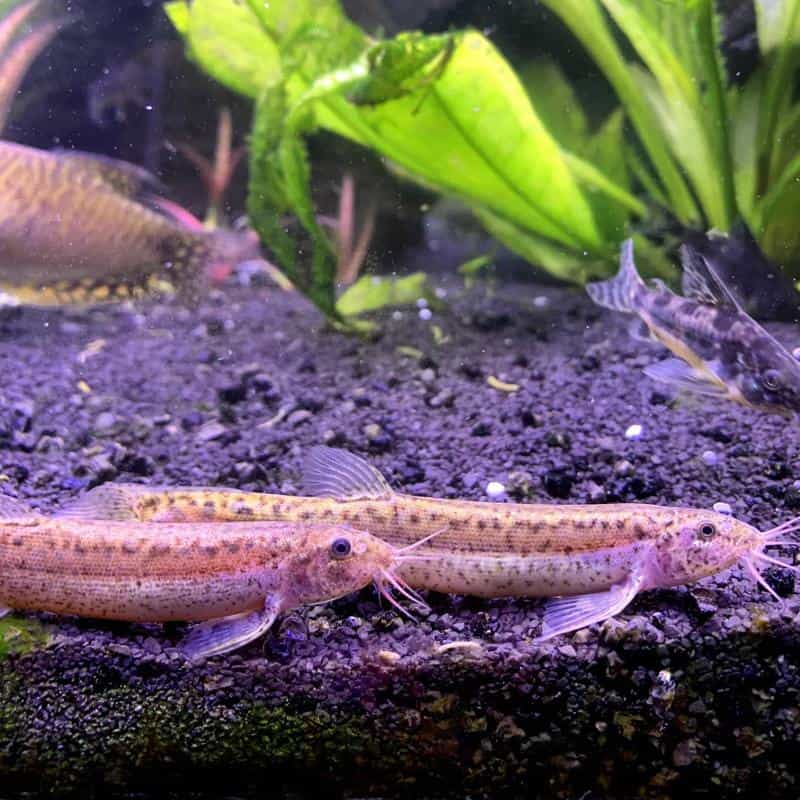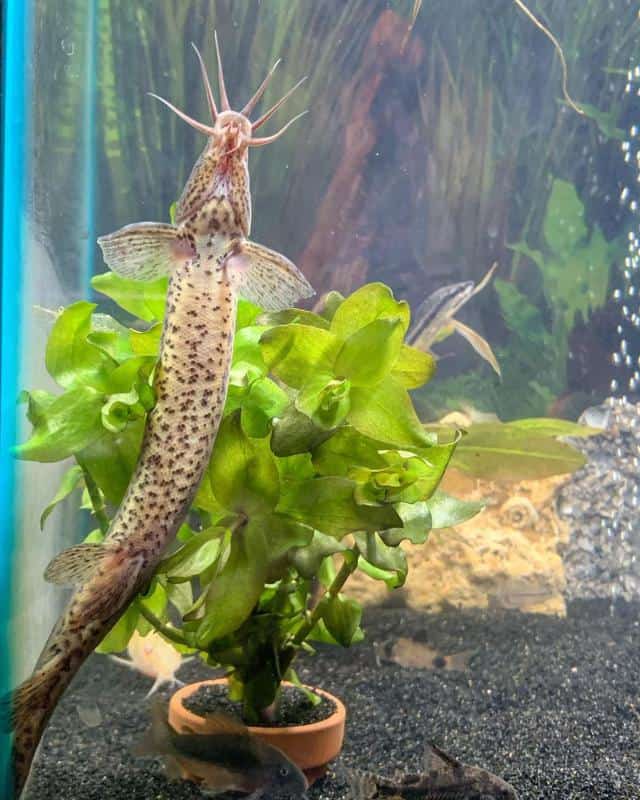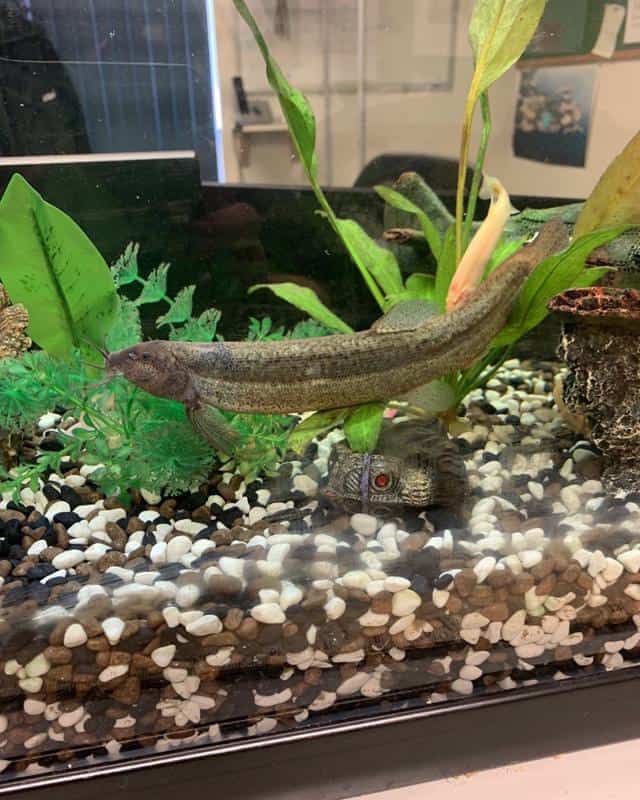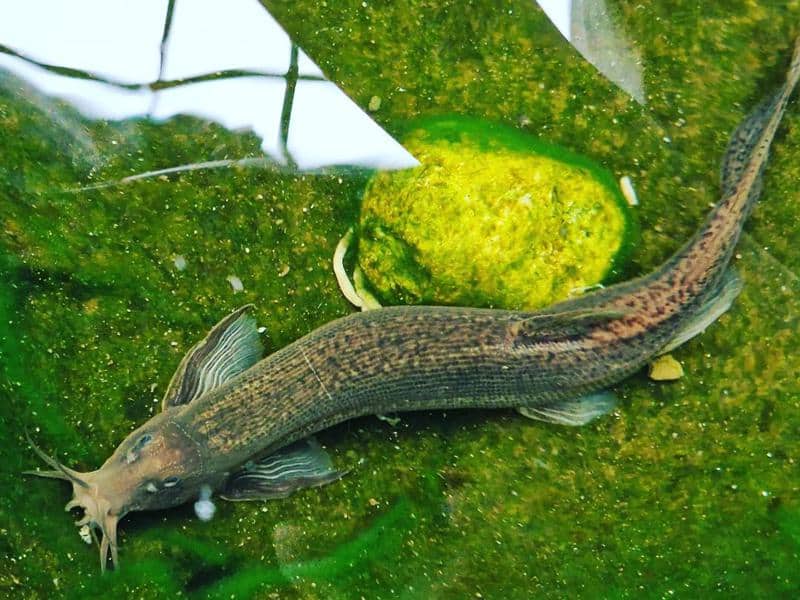When it comes to fishkeeping, beauty isn’t everything. Many have become captivated by the Dojo Loach for its interesting character.
And believe it or not, the rumors are true. The Dojo Loach, aka Weather Loach, can help predict an approaching storm. How?
In this article, you will discover many things that make this species enchanting! Should you wish to care for these fish, you will learn how to provide them with the best life possible. So even in captivity, they will feel happy and free.
Dojo Loach Overview

| Scientific Name | Misgurnus anguillicaudatus |
| Size | 8 inches in captivity (20 cm)
12 inches in the wild (31 cm) |
| Life Expectancy | 5 years in captivity
10 years in the wild |
| Temperament | Docile and peaceful; will interact with its owners |
| Diet | Omnivorous |
| Tank Size | 40 gallons for a group of 3 |
| Tank Temperature | 58-77º F (14-25º C) |
| Water Hardness | 5-12 dGH |
| Water pH | 6.5-8 |
Dojo Loach in the Wild
Dr. Theodore Cantor described the Dojo Loach in 1842 and gave it its scientific name Misgurnus anguillicaudatus. But even before Cantor’s discovery, the fish was wildly popular among the Japanese.
The Dojo Loach was an important protein source for the working class during the Edo period. Local residents in Edo, now Tokyo, created several recipes that are still in use at Komakata Dozeu and other specialty restaurants.
The species is likewise abundant in China and Korea where people harvest them for food. After World War II, the Japanese introduced the Dojo Loach to the Philippines for aquaculture.
The Dojo Loach inhabits streams and slow-moving rivers. There, the fish spend most of their time foraging for food at the bottom. Also called the Pond Loach, they can likewise thrive in rice paddies and deep ponds.
However, this native of Asia has become an invasive species in Australia. The Australian Capital Territory confirmed its existence in 1980.
Dojo Loach Size and Growth Rate
The Dojo Loach can grow up to a foot long in its natural habitat. A fast-growing species, they can reach their maximum size within four years or less. Most captive specimens max out at 8 inches (20 centimeters).
What Does a Dojo Loach Look Like?

The Dojo Loach is often mistaken for a juvenile eel due to its slippery, elongated body. Its cylindrical body flattens out towards its tail, which further cements the eel-like look.
The fish features a pointed head with a humorous expression. Twelve barbels, which could almost pass for cat whiskers, edge its mouth.
The dorsal fin is on the last third of its body, close to the tail. The pectoral fins, which the fish use for navigation, are behind its gills.
Do Dojo Loaches Vary in Color? Yes!
Dojo Loaches can be gray, light brown, or olive green. For some fish, the color regresses toward their undersides, creating a gradient effect. Others feature dark brown spots on their bellies.
Moreover, breeders have achieved a gold variation. Referred to as the Gold Dojo Loach, these fish flaunt a golden yellow color with orange hues.
You may also spot the Albino Dojo Loach in the aquarium trade. Albinos are paler than their commercially bred counterparts and they have red eyes.
How Do Dojo Loaches Behave?
To understand if your pet fish are thriving, it is important to find out how the species behaves in the wild.
Dojo Loaches Can Breathe Through Their Skin
Some fish species have adapted to survive in low-oxygen environments by evolving alternative breathing mechanisms alongside gills. In the case of the Dojo Loach, it’s the intestines.
The posterior intestine of the Dojo Loach is teeming with narrow capillaries that absorb atmospheric oxygen. When the water is dangerously deprived of dissolved oxygen, the loaches would resort to intestinal breathing.
This explains why these fish would sometimes swim toward the water’s surface, as they would gasp for air. Likewise, this also explains why the Dojos are notorious for their farts!
They Love to Bury Themselves
Once in a while, Dojos may bury themselves in the soft substrate to rest. Sometimes, they may leave their heads poking out.
The fish may also behave this way to hide from their tank mates. This is especially true when they are still adjusting to their new home.
In the wild, Dojos would bury themselves underneath the mud during a drought. They would only emerge when the water comes back.
Are Dojo Loaches Friendly?
The Dojo Loach temperament is suitable for a community setup.
At first, they may feel threatened to stay in the open and act reclusive. But once they’ve settled in, you’ll get to witness their amusing character.
Although Dojos don’t school together, they need to be in a group of at least three to feel safe.
Why Are They Called Weather Loaches?
The common name “Weather Loach” came about because the Dojo Loach can predict bad weather. This is due to the species’ hypersensitivity to atmospheric changes. When a storm is brewing, the fish get agitated and swim in erratic unpredictable ways.
Dojo Loach Lifespan
Granted that you have provided optimal care and maintenance of your fish’s environment, they may live up to 5 years or longer. In the wild, the Dojo Loach can live around 10 years.
Tank Setup

Dojo Loaches don’t need an elaborate tank, but you should replicate their natural habitat as much as possible in captivity.
Tank Size
For a group of three, start with a 40-gallon tank or bigger. Since Dojo Loaches are bottom dwellers, you’ll need a long wide tank to provide them ample room to slither back and forth.
Dojo Loaches, even as juveniles, want a tank over 4 feet long. The height won’t be as important as the width — unless you’re stocking your tank with different levels of fish.
Substrate
While fine gravel is acceptable, the best substrate for Dojo Loach is sand. Dojos like to burrow and use their barbels to search for yummy tidbits. Coarse substrates could only injure your fish.
Ideally, you’ll want to keep the sand layer up to two inches. Make it three if your tank has a 55-gallon capacity or larger.
Plants and Decorations
Add a few pieces of driftwood and smooth stones on the side of the tank to mimic the species’ natural habitat. Choose plants that can tolerate cool temperatures, such as:
- Amazon Sword Plant (Echinodorus grisebachii)
- Anacharis (Egeria densa)
- Anubia (Anubias barteria)
- Hornwort (Ceratophyllum demersum)
- Fountain Plant (Ophiopogon japonicus)
- Java Fern (Microsorum pteropus)
- Java Moss (Taxiphyllum barbieri)
- Red Leaf Ludwigia (Ludwigia repens)
- Marimo Moss Balls (Aegagropila linnaei)
- Water Trumpet (Cryptocoryne wendtii)
Dojos may dig up rooted plants when they are searching for food. So, place a flat stone or any other voluminous buffer between the stems and substrate. There shouldn’t be problems once your plants develop strong roots.
Equipment and Accessories
For starters, you’ll need a canister filter. Dojo Loaches are relentless foragers, which makes them fun to watch. That also means they expel a lot of waste.
Likewise, I strongly recommend adding a cover as a precaution. Dojos can and will jump out of your tank.
These fish prefer dim lighting, so an LED is unnecessary.
Water Parameters

A barometer of clean water, the Dojo Loach fares badly if the oxygen levels plummet and nitrate readings soar. As in the wild, the species’ population decreased due to their exposure to industrial and municipal wastes. In that light, investing in a high-quality filter, water pump, and aquarium test kit is crucial to keep your water quality up.
Water Temperature
Dojo Loaches are happiest when the water temperature is between 58 to 77 degrees Fahrenheit (14 – 25º Celsius). These fish can assimilate warmer temperatures but will have a shorter lifespan if you house them in a tropical aquarium.
Water Flow Rate
Given that Dojos come from rivers and streams, they will appreciate having a decent current in their tank. A canister filter should already provide good flow, but the more water movement you can create in your tank, the better.
You can increase dissolved oxygen in your aquarium by:
- Adding live plants
- Adding a bubbler or multiple air stones
- Carry out partial water changes every week
Achieving high oxygen levels is the goal. However, ensure there are also a few quiet corners for other fish to relax.
Water Hardness and pH
Maintain the water pH between 6 to 8. Moreover, these fish will do best in soft to medium water hardness.
Diet and Feeding
Dojo Loaches don’t need special food. These enthusiastic foragers will scarf down anything available. And if you have a snail problem, these loaches are eager to eliminate them.
But if you want to get your pets nice and plump, feed them with a varied diet of:
- Sinking foods like Tetra Shrimp Wafers and Aqueon Bottom Feeder Tablets
- Live snacks like blackworms, bloodworms, and Tubifex
- Thin slices of broccoli or zucchini
You don’t want your loaches to rely on leftovers. Take note; Dojos will not compete for food. If their tankmates are hogging all the chow, try feeding them at night when the lights are off.
Breeding
Despite being one of the easiest fish to care for, Dojo Loaches aren’t the easiest to breed. Those who were successful in loach cultivation operated a village-level fish hatchery.
It’s nearly impossible for the average aquarist to meet the requirements needed to encourage Dojos to breed.
Best Dojo Loach Tank Mates

The fish you seek must require the same water temperature as Dojo Loaches to ensure all species thrive. Avoid fish species that get competitive and aggressive, especially during mealtimes.
Here is a list of the best tank mates for Dojo Loaches:
- Bichir (Polypteridae)
- Bloodfin Tetra (Aphyocharax anisitsi)
- Buenos Aires Tetra (Psalidodon anisitsi)
- Goldfish (Carassius auratus)
- Harlequin Rasbora (Trignostigma heteromorpha)
- Kissing Gourami (Helostoma temminkii)
- Paradise Fish (Macropodus opercularis)
- Pearl Danio (Danio albolineatus)
- Rosy Barb (Puntius conchonius)
- Serpae Tetra (Hyphessobrycon eques)
- Tiger Barb (Barbus tetrazona)
- Two Spot Barb (Pethia ticto)
- White Cloud Minnow (Tanichthys albonubes)
- Zebra Danio (Danio Rerio)
Since Dojo Loaches can grow 6 to 8 inches long, it would be best to focus more on species that occupy the top and middle columns, instead of adding another bottom dweller.
Can You Keep Kuhli Loaches with Dojos?
Some sources would say it’s okay to keep Kuhli Loaches with Dojo Loaches. However, Kuhlis are tropical fish and thus need a heated tank.
Common Diseases
All fish are susceptible to diseases, but the Dojo Loach is even more so.
Ich
Dojos have thinner, nearly invisible scales that offer them little protection against fish louse or Ich.
Often, the fish acquires Ich as a result of stress brought by incompatible tankmates, unstable water parameters, and so forth.
Here are the signs that a Dojo Loach has Ich:
- white spots that look like sprinkled salt
- frequent scratching against tank walls and decor
- lethargy
I can’t stress enough how important it is to quarantine your fish for two weeks before introducing them into your main tank. If your loaches have gone down Ich, you can use quinine to cure it.
Dojo Loaches don’t respond well to typical copper-based treatments or formulas containing formalin and malachite green.
Bloating
Another common problem associated with Dojo Loaches is bloating. Many factors can cause bloating, including gas and indigestion.
Fish, like Dojo Loaches, are pigs when it comes to food. To prevent indigestion, you need to feed your fish a balanced diet and make sure you aren’t overfeeding them.
Your fish can address a simple gas problem by farting. However, a bloated belly could also mean parasitic infections.
Consult an aquatic vet for an accurate diagnosis. The vet will prescribe medication suitable for this sensitive species.
Wrapping Up
The Dojo Loach, also called Weather Loach and Pond Loach, is an excellent fish to have. Once the fish get comfortable, they exhibit amusing comical behaviors and may even interact with their owners.
They are straightforward to care for and their docile nature makes them a perfect addition to a cold freshwater aquarium.
However, Dojos can easily fall prey to Ich and parasites. But by following recommendations and observing precautions as stated above, you can avoid fatal consequences.
Are you thinking of getting Dojo Loaches soon? Do you currently own a few? Share with us your thoughts and fun experience in the comments section below!